
In Ireland at the end of the sixteenth and beginning of the seventeenth century, the fortified house, along with the stronghouse, developed as a replacement for the tower house. 'Fortified Houses' were often rectangular, or sometimes U or L-shaped, three-storey structures with high gables and chimney stacks and large windows with hood mouldings. Some examples have square towers at the corners. The interiors were relatively spacious with wooden partitions and numerous fireplaces. In a number of cases 'Fortified Houses' were built onto pre-existing tower houses. 'Fortified Houses' were protected by gun fire from the angle towers and bartizans, and were also provided with bawn walls with gunloops, towers and protected gateways. 'Fortified Houses' were built throughout Ireland by large landowners from a variety of backgrounds, such as the Old English Earl of Clanricarde who built Portumna Castle in County Galway; Gaelic lords such as MacDonogh MacCarthy, Lord of Duhallow, who built Kanturk Castle in County Cork; and Cromwellian soldiers such as Sir Charles Coote, who built Rush Hall in County Offaly.
Over the past six decades studies concerning Irish 'Fortified Houses' have identified them as a transitional genre that emerged at the end of the sixteenth century and acted as an architectural bridge between the Irish medieval tower-house and the country manor house of the late seventeenth century. The 'Fortified House' drew on the earlier tradition of the tower-house and was influenced by the Tudor and emerging Jacobean architecture from England and the Classical and Military architecture coming from Continental Europe. The social, political and military changes that took place from the 1580s-1650s were to play a major role in the development of this unique Irish structure. These houses provided a comfortable living space for the elite of early seventeenth-century Irish society. They were fashionable yet defendable. The 'Fortified House' was a public display of power and wealth. They represented a long term investment in their owner’s regional future and were monuments to an aspiration for an English and Continental house style suited to local Irish conditions. On a basic level the construction of a 'Fortified House' represented the owners’ desire to modernise and Anglicize.
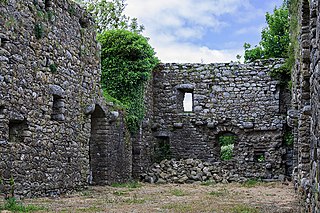
Rathumney Castle is a hall house and National Monument located in County Wexford, Ireland.

Rathmacknee Castle is a tower house and National Monument located in County Wexford, Ireland.
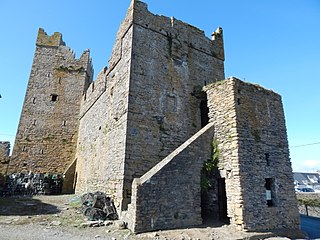
Slade Castle is a tower house and National Monument in County Wexford, Ireland. It is located in the village of Slade on the Hook Peninsula and primarily dates to the late 15th or early 16th century.

Roodstown Castle is a 15th-century tower house and National Monument located in County Louth, Ireland.

Roscrea Castle is a 13th-century motte-and-bailey castle in the town of Roscrea, Ireland. The castle consists of a walled courtyard, gate block, and angled towers. Along with 18th century Damer House and gardens, the castle forms part of Roscrea Heritage Centre.

Athenry Castle is a tower house and National Monument located in Athenry, Ireland.
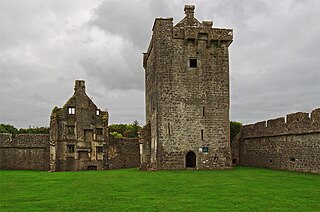
Pallas Castle is a tower house and National Monument located in County Galway, Ireland.

Johnstown Castle is a Gothic Revival castle located in County Wexford, Ireland.
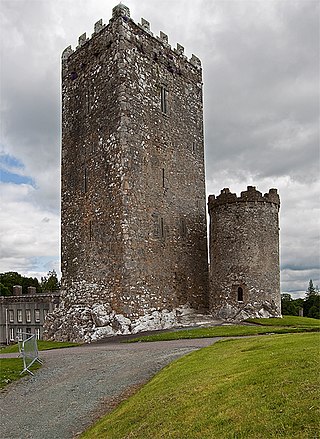
Drishane Castle is a MacCarthy tower house and National Monument located in County Cork, Ireland. In modern times the name is also used to refer to the adjacent house which dates from the 18th century. It is located 2.2 km (1.4 mi) northeast of Millstreet, on the south bank of the Munster Blackwater.

Glenquin Castle is a tower house and National Monument located in County Limerick, Ireland.

Fanning's Castle, also called Whitamore's Castle, is the remains of a tower house and National Monument located in Limerick, Ireland.

Ballymalis Castle is a tower house and National Monument located in County Kerry, Ireland.

Isert Kelly Castle is a tower house and National Monument located in County Galway, Ireland.

Ardamullivan Castle is a tower house and National Monument located in County Galway, Ireland.

Dunmore Castle is a castle and National Monument located in County Galway, Ireland.
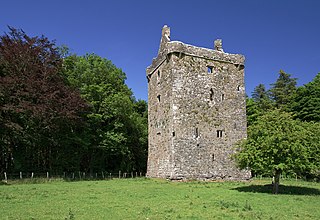
Feartagar Castle, also called Jennings Castle, is a tower house and National Monument located in County Galway, Ireland.
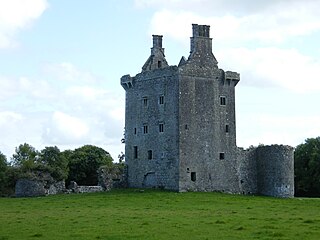
Derryhiveny Castle is a tower house and National Monument located in County Galway, Ireland.

Kiltartan Castle is a tower house and National Monument located in County Galway, Ireland.

Desmond Hall and Castle, also called Desmond Castle and Banqueting Hall or Newcastle West Medieval Complex and Desmond Hall, are a set of medieval buildings and National Monuments located in Newcastle West, Ireland. For over 200 years, it belonged to the Fitzgerald family, Earls of Desmond.





















